Model 167 "Maryland"

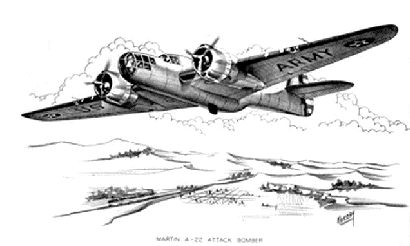
Designed as an attack bomber in 1938, the Martin XA-22 failed to win any production contracts with the USAAF. In 1939 Martin looked for buyers overseas, and under the designation Model 167 (named the Maryland) sales were made to Britain, France, and South Africa. The Maryland found its purpose not as an attack bomber, though, but rather as a medium-range high-speed reconnaissance aircraft. It performed these duties well, until it was replaced by more advanced types.
Type: reconnaissance/bomber aircraft
Crew: 3
Armament: four .30 inch machine guns in wings
two .303 inch machine guns (1 in ventral
and 1 in dorsal gun position)
up to 2,000 lbs. of bombs
Specifications:
Length: 46' 8" (14.22 m)
Height: 14' 11.75" (4.57 m)
Wingspan: 61' 4" (18.69 m)
Wing area: 538.5 sq. ft (50.03 sq. m)
Empty Weight: 11,213 lb (5086 kg)
Max Weight: 16,809 lb (7624 kg) max at takeoff
Propulsion:
No. of Engines: 2
Powerplant: Pratt & Whitney R-1830-SC3G Twin Wasp radial
Horsepower: 1050 hp each
Performance:
Range: 1300 miles (2092 km)
Cruise Speed: 248 mph ( 399 km/h)
Max Speed: 304 mph ( 489 km/h) at 13,000 ft
Ceiling: 29,500 ft (8990 m)
Martin 187 (A-30) Baltimore
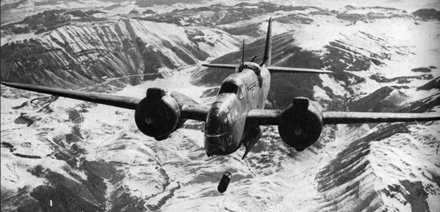
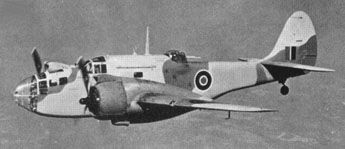
The Martin Baltimore was developed from its predecessor the Martin 167 Maryland to meet specific British requirements. It was used with distinction by a number of Allied air forces in Europe, and was liked by its pilots for its superior performance and great structural strength. One drawback that it shared with the Maryland was the very narrow fuselage, which made it virtually impossible for crew members to change position in flight if injured.
Type: twin-engined light bomber
Crew: 4
Armament: four .303 inch machine guns in wings
2-4 .303 inch machine guns in dorsal turret
two .30 inch machine guns in ventral position
up to 2,000 lbs. of bombs
Specifications:
Length: 48' 5.75" (14.78 m)
Height: 17' 9" (5.41 m)
Wingspan: 61' 4" (18.69 m)
Wing area: 538.5 sq. ft (50.03 sq. m)
Empty Weight: 15,460 lb (7013 kg)
Max Weight: 22,600 lb (10,521 kg) max at takeoff
Propulsion:
No. of Engines: 2
Powerplant: Wright GR-2600-A5B Cyclone 14 radial
Horsepower: 1660 hp each
Performance:
Range: 1082 miles (1741 km)
Cruise Speed: 225 mph ( 362 km/h)
Max Speed: 305 mph ( 491 km/h) at 11,500 ft
Ceiling: 23,300 ft (7100 m)
Martin B-10/B-12
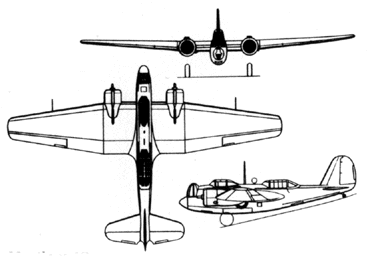
After failing in a number of bomber design competitions in the 1930s, the Glenn L. Martin company designed and built an advanced bomber project as a private venture. This aircraft was known as the Martin 123, and when tested by the U.S. Army in 1932 it was given the experimental designation XB-907. After modifications (which included better engines and the installation of a front gun turret, the first to be installed in a U.S. bomber) this aircraft proved to be faster than any of the U.S. fighters of the time. In 1933 the Army contracted for 48 aircraft to be built under the designation XB-10. The production version (Martin 139) began to enter service in 1934. This all-metal monoplane bomber carried a crew of four or five in three separate cockpits. It remained in service with the USAAC until it was replaced by Boeing B-17d and Douglas B-18s in the late 1930s. 189 examples were built for export, with 120 going to the Netherlands East Indies. These were amongst the first U.S.-built bombers to see operational service at the beginning of WWII.
Type: light bomber
Crew: 4-5
Armament: three .30 inch machine guns in nose (1 each
in the nose and rear turrets,
1 in ventral gun position)
up to 2,260 lbs. of bombs
Specifications:
Length: 44' 9" (13.64 m)
Height: 15' 5" (4.70 m)
Wingspan: 70' 6" (21.49 m)
Wing area: 678 sq. ft (62.99 sq. m)
Empty Weight: 9,681 lb (4391 kg)
Max Weight: 16,400 lb (7439 kg) max at takeoff
Propulsion:
No. of Engines: 2
Powerplant: Wright R-1820-33 Cyclone 9 radial
Horsepower: 775 hp each
Performance:
Range: 1240 miles (1996 km)
Cruise Speed: 193 mph ( 311 km/h)
Max Speed: 213 mph ( 343 km/h) at 6,000 ft
Ceiling: 24,200 ft (7375 m)
Boeing B-17 Flying Fortress
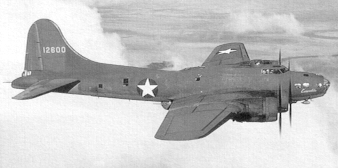
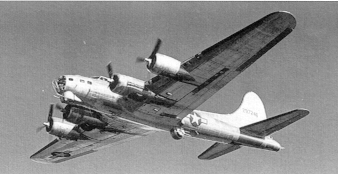
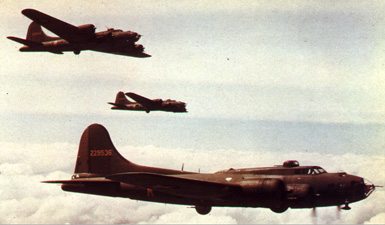
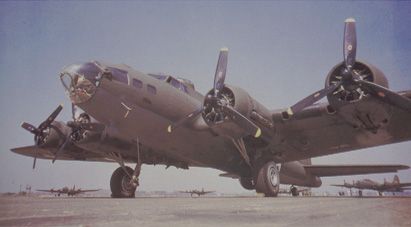
One of the most well-known bombers of all time, the B-17 Flying Fortress became famous in the long daylight bombing raids over Europe in WWII. While it lacked the range and bombload of its contemporary the B-24 Liberator, the B-17 became the more famous of the two due to the many tales of B-17s bringing their crews back home despite heavy damage. With up to thirteen machine guns, the B-17 seemed to be a genuine flying "fortress in the sky". However, bomber losses reached the unacceptable point in 1943 in the face of stiff German opposition, and the B-17s had to wait until the introduction of long-range fighter escort before they could continue their war against the Reich. (Also, see the page on the YB40, which was a heavily-armed B-17 meant to escort other B-17s.)
Type: Heavy bomber
Crew: 10: Pilot, Co-Pilot, Engineer, Bombardier, Radioman, 5 Gunners
Armament: thirteen .50 cal machine guns (G model)
up to 17,600 lbs. of bombs
Specifications:
Length: 74' 4" (22.66 m)
Height: 19' 1" (5.82 m)
Wingspan: 103' 10" (31.65 m)
Gross Weight: 55000.0 lb
Propulsion:
No. of Engines: 4
Powerplant: Wright R-1820 Cyclone
Horsepower: 1200 hp each
Performance:
Range: 1850 miles w/ 4000 lb. bombload
Cruise Speed: 170 mph (273 km/h)
Max Speed: 300 mph (483 km/h)
Ceiling: 35000 ft (10667 m)
Douglas B-18 Bolo

Developed from the DC-2 civil transport, the Douglas DB-1 was designed in 1934 as a replacement for the USAAC's standard bomber, the B-10. The DB-1 was the losing contender in the USAAC contest, which was won by the Boeing B-17. Despite this, the DB-1 entered production as the B-18, with most of the USAAC's bomber squadrons being equipped by B-18s or B-18A's in 1940. The majority of the 33 B-18A's stationed with the USAAC in Hawaii in 1941 were destroyed in the Japanese attack on Pearl Harbor. When the B-1 8 was replaced in first-line service by the B-17 in 1942, some 122 B-18s were equipped magnetic anomaly detection (MAD) equipment for deployment in the Caribbean on anti-submarine patrol. Some B-18s were used for transport duty, with a portion of these designated C-58s.
Type: medium bomber and ASW aircraft
Crew: 6
Armament: three 0.30 inch machine guns
up to 6,500 lbs. of bombs
Specifications:
Length: 57' 10" (17.63 m)
Height: 15' 2" (4.62 m)
Wingspan: 89' 6" (27.28 m)
Wing area: 965 sq. ft (89.65 sq. m)
Empty Weight: 16,321 lb (7403 kg)
Max Weight: 27,673 lb (12,552 kg) max at takeoff
Propulsion:
No. of Engines: 2
Powerplant: Wright R-1820-53 Cyclone 9 radial
Horsepower: 1000 hp
Performance:
Range: 1200 miles (1931 km)
Cruise Speed: 167 mph ( 269 km/h)
Max Speed: 215 mph ( 346 km/h) at 10000 ft
Ceiling: 23,900 ft (7285 m)
Douglas B-23 Dragon

In an attempt to rectify the shortcomings of their DB-1 Design, the Douglas team developed an improved version of the aircraft in 1938. The USAAC awarded a contract for this new design under the designation B-23 Dragon. First flown in July 1939, the 33 examples of the B-23 proved to have disappointing performance and flight characteristics. As a result the Dragon saw only limited service in a patrol capacity before being relegated to training duties. Twelve examples were later modified as utility transports (as VC-67s), and were also used as glider tugs.
Type: medium bomber
Crew: 4-5
Armament: one 0.50 inch machine gun
three 0.30 inch machine guns
Specifications:
Length: 58' 4" (17.78 m)
Height: 18' 6" (5.64 m)
Wingspan: 92' 0" (28.04 m)
Wing area: 993 sq. ft (92.25 sq. m)
Empty Weight: 19,059 lb (8645 kg)
Max Weight: 30,475 lb (13,823 kg) max at takeoff
Propulsion:
No. of Engines: 2
Powerplant: Wright R-2600-3 Cyclone 14 radial
Horsepower: 1600 hp each
Performance:
Range: 1455 miles (2342 km)
Cruise Speed: (not listed)
Max Speed: 282 mph ( 454 km/h) at 12000 ft
Ceiling: 31,600 ft (9630 m)
Consolidated B-24 Liberator
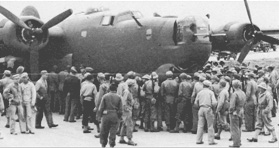
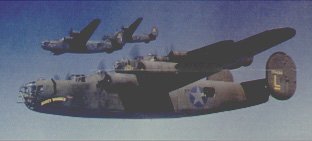

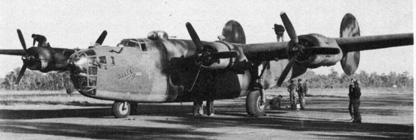
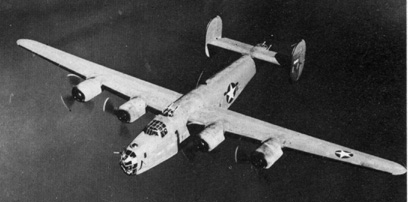
The B-24 Liberator was not only built in considerably greater numbers than the famous B-17 Fortress, but it was the most extensively produced of all of the U.S. wartime aircraft. It served in all theaters of combat, delivering large bomb loads over long distances. It had easily recognizable oval-shape endplate fins and rudders, and unique 'roller shutter' doors which retracted within the fuselage when opened for attack, causing less drag than conventional bomb-bay doors which opened into the slipstream. B-24s operating with the US Navy were known as PB4Ys, and those modified as transports were designated C-87s. A experimental gunship (bomber escort) version was designated XB-41. A similar aircraft with a single tail rudder and standard stabilizers was developed as a Navy Patrol bomber, and was designated the PB4Y-2 Privateer. A photographic reconnaissance version was known as the F7.
Type: Heavy Bomber
Crew: 11,
Armament: ten .50 cal machine guns
up to 12,800 lbs. of bombsSpecifications:
Length: 67' 8" (20.6 m)
Height: 18' (5.5 m)
Wingspan: 110' (33.5 m)
Gross Weight: 55,000 lb
Propulsion:
No. of Engines: 4
Powerplant: Pratt & Whitney R-1830
Horsepower: 1200 hp each
Performance:
Range: 2300 miles w/ 5000 lb. bombload
Cruise Speed: 175 mph (281.00 km/h)
Max Speed: 303 mph (487.00 km/h)
Ceiling: 28000 ft (8534.00 m)
North American B-25 Mitchell
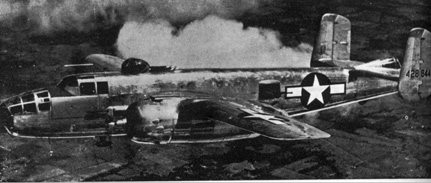
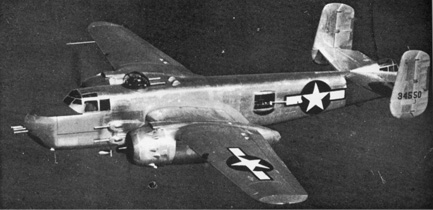
The B-25 was a very versatile medium bomber that was used on all fronts. An example of its versatility can be seen in its use by Jimmy Doolittle, who led a raiding group of B-25s off of the deck of the carrier Hornet to bomb the Japanese home islands in April 1942. Armament continually changed during the evolution of the B-25, from the B model with a glass nose and a single fifty caliber machine gun, to the G model that carried a 75mm cannon in the nose, to the later version of the J model that had a solid nose with eight .50 calibers, fuselage blisters with four more forward-firing .50s, and six more .50s in other fuselage positions. The USAAF was not the only service to use the B-25. Over 700 Mitchells were delivered to the U.S. Navy and Marines, under the designation PBJ. Many Allied nations also used the B-25, some continuing in use until the 1960's.
Type: five-seat medium bomber
Crew: 5
Armament: two to eighteen .50 cal machine guns
up to 3,000 lbs. of bombs
Specifications:
Length: 52' 11" (16.13 m)
Height: 16' 4" (4.98 m)
Wingspan: 67' 7' (20.42 m)
Wing area: 610.5 sq. ft (56.67 sq. m)
Empty Weight: 19480 lb (8834 kg)
Gross Weight: 34999 lb (15873kg)
Max Weight: 35000 lb (15873kg)
Propulsion:
No. of Engines: 2
Powerplant: Wright R-2600-13
Horsepower: 1700 each
Performance:
Range: 1350 miles (2173 km)
Max Speed: 272 mph (438 km/h)
Ceiling: 24200. ft (7375.80 m)
Martin B-26 Marauder
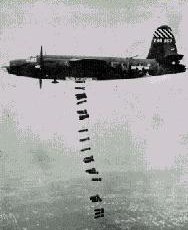
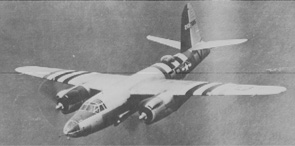
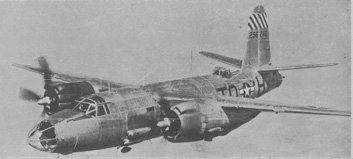
Unfortunately known by some as "The WidowMaker", the B-26 earned its nickname and a lot of bad press due to a high number of crashes that occurred early in its career. Official investigations resulted in wing area increases and changes in training, the result being that the B-26 ended up with the lowest attrition rate of all the bombers in the 9th Air Force. The Marauder had a higher top speed and a larger bomb load than the B-25 Mitchell, but it was not quite as adaptable, and its fame suffered as a result.
Type: seven-seat medium bomber
Crew: seven
Armament: eleven .50 cal machine guns
up to 4,000 lbs. of bombs
Specifications:
Length: 56' 1" (17.09 m)
Height: 20' 4" (6.20 m)
Wingspan: 71' (21.64 m)
Gross Weight: 37000 lb
Propulsion:
No. of Engines: 2
Powerplant: Pratt & Whitney R-2800-43 Double Wasp radial
Horsepower: 1920 hp each
Performance:
Range: 1100 miles (1771.00 km)
Cruise Speed: 216 mph (348 km/h)
Max Speed: 285 mph (458.00 km/h)
Ceiling: 19800 ft (6034.7 m)
Boeing B-29 Superfortress
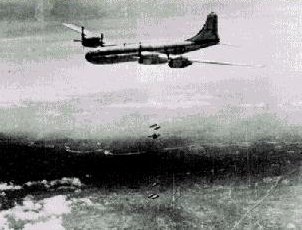
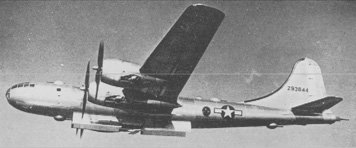
The B-29 Superfortress was used by the 20th Air Force in the Pacific to bomb the Japanese Home Islands. It was a very advanced bomber for its day, with pressurized crew compartments and remote-controlled gun turrets. While envisioned as a high altitude daylight bomber, its greatest successes were low-level nighttime raids and dropping incendiary bombs on the combustible Japanese cities. The B-29 is most known for dropping the Atomic bombs on Hiroshima and Nagasaki, which ended the war in the Pacific.
Type: Long-range Strategic Heavy bomber
Crew: 10: Pilot, Co-Pilot, Engineer, Bombardier, Radioman, 5 Gunners
Armament: eight .50 cal machine guns (two in each of four power turrets)
three.50 cal machine guns (or two .50 cals and one 20mm cannon) in the tail turret
up to 20,000 lbs. of bombs
Specifications:
Length: 99' 0" (30.18 m)
Height: 29' 7" (9.02 m)
Wingspan: 141' 3" (43.05 m)
Weight: 124,000 lb max at takeoff
Propulsion:
No. of Engines: 4
Powerplant: Wright R-3350-23 Cyclone 18
Horsepower: 2200 hp each
Performance:
Range: 3250 miles (5230 km)
Cruise Speed: 230 mph (370 km/h)
Max Speed: 358 mph (576 km/h)
Ceiling: 31850 ft (9710 m)
Consolidated B-32 Dominator
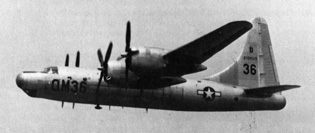
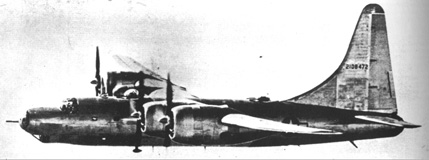
The Dominator was designed by Consolidated to meet an Air Force specification that also resulted in the competing Boeing B-29 Superfortress. Each company won contracts to produce aircraft, but Consolidated ran into problems with the B-32 development. Like the B-29, the B-32 had pressurized crew compartments and remotely-controlled gun turrets. When the production examples of the B-32 were delivered in November 1944, however, these two features had been deleted from the aircraft. Only 15 aircraft were to become operational before VJ-Day (plus another 40 training examples), but at the end of the war all versions were very soon withdrawn from service.
Type: long range strategic bomber
Crew: 8
Armament: two 20mm cannon (one in nose, one in tail)
four .50 cal machine guns
up to 20,000 lbs. of bombs
Specifications:
Length: 83' 1" (25.32 m)
Height: 33' 0" (10.06 m)
Wingspan: 135' 0" (41.15 m)
Wing area: 1422 sq. ft (132.10 sq. m)
Empty Weight: 60,272 lb (27,229 kg)
Max Weight: 111,500 lb (50,576 kg) max at takeoff
Propulsion:
No. of Engines: 4
Powerplant: Wright R-3350-23 Cyclone radial
Horsepower: 2200 hp each
Performance:
Range w/max bombload: 800 miles (1287 km)
Max Range: 3800 miles (6115 km)
Cruise Speed: (not listed)
Max Speed: 357 mph ( 575 km/h) at 25000 ft
Ceiling: 35,000 ft (10,760 m)
Lockheed B-34/PV Ventura/Harpoon
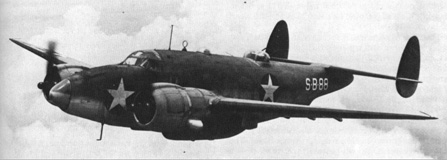
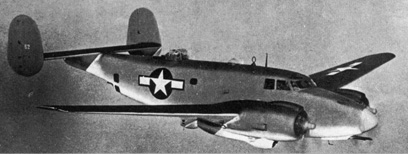
The early success of the Lockheed Hudson resulted in the development of a more advanced design for the British, to be named the B-34. These first entered service in October 1942. Later designated the Ventura I, the new aircraft differed from the Hudson in having a wider and deeper fuselage with a length increase of 16%, more powerful engines, the introduction of a proper ventral gun position, and a larger bomb bay. As aircraft were transferred between the Lend-Lease program, the USAAF, and the U.S. Navy, designations went from B-34 to R-37 to B-37 to PV-3. The Navy received its first quantities in December 1942 as the PV-1 (Ventura). In June 1943 the Navy ordered a new version under the designation PV-2 and with the name Harpoon. This version had the wingspan increased by 9 feet, increased fuel capacity, greater fin and rudder area, and improved armament (five .50 cal forward firing machine guns in the nose, two 50 cal machine guns in both dorsal turret and ventral position, and up to four 1000 lb. bombs internally with two 1000 lb. bombs externally). The PV-2 served primarily in the Pacific theater, and was well-used until the end of the war.
Lockheed PV-1 Ventura
Type: patrol bomber
Crew: 4-5
Armament: two forward firing .50 cal machine guns
two .50 cal machine guns in dorsal turret
two .30 cal ventral machine guns
six 500 lb. bombs or one torpedo in internal bomb bay
up to two 1000 lb. bombs externally
Specifications:
Length: 51' 9"
Height: 11' 11" (3.63 m)
Wingspan: 65' 6" (19.96 m)
Wing area: 551 sq. ft (51.19 sq. m)
Empty Weight: 20,197 lb
Gross Weight: 31,077 lb
Propulsion:
No. of Engines: 2
Powerplant: Pratt & Whitney R-2800-31 Double Wasp radial
Horsepower: 2000 hp each
Performance:
Range: 1660 st miles
Cruise Speed: 164 mph
Max Speed: 312 mph at 13,800 ft
Ceiling: 26,300 ft
Type: patrol bomber
Crew: 4-5
Armament: five fixed forward firing .50 cal machine guns
two flexible .50 cal machine guns in dorsal turret
two flexible .50 cal machine guns in ventral mount
six .30 cal machine guns on flex mounts
up to four 1000 lb. bombs in internal bomb bay
up to two 1000 lb. bombs externally
Specifications:
Length: 52' 0.5"
Height: 11' 11"
Wingspan: 74' 11"
Wing area: 686 sq. ft
Empty Weight: 21,028 lb
Gross Weight: 36,000 lb
Propulsion:
No. of Engines: 2
Powerplant: Pratt & Whitney R-2800-31 Double Wasp radial
Horsepower: 2000 hp each
Performance:
Range: 1790 st miles
Cruise Speed: 171 mph
Max Speed: 282 mph at 13,700 ft
Ceiling: 23,900 ft
Consolidated PB4Y Privateer
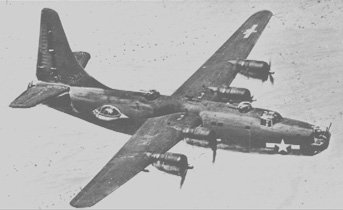
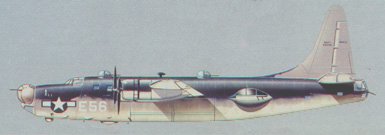
The PB4Y-2 Privateer was designed for a 1943 U.S. Navy contract to develop a naval variation of the B-24 Liberator. It was distinguished from the B-24 by having a new tail unit (with a tall single tail fin and rudder), a lengthened forward fuselage, changes in armament (two Martin dorsal turrets, an Erco nose ball turret and Erco two-gun 'teardrop' blisters on each side of the fuselage), and different engines (which had round instead of oval cowlings). The Privateer survived long after WWII, seeing service in the Korea. A few examples still remain in use today as fire-fighting bombers.
Type: land-based maritime patrol bomber
Crew: 11, 2 pilots, navigator, bombardier, 5 gunners, 2 radio operators
Armament: twelve .50 cal machine guns
up to 12,800 lbs. of bombs
Specifications:
Length: 74' 7" (22.73 m)
Height: 30' 1" (9.17 m)
Wingspan: 110' 0" (93.53 m)
Wing area: 1048 sq. ft (97.36 sq. m)
Empty Weight: 37,485 lb (17,003 kg)
Max Weight: 65,000 lb (? kg) max at takeoff
Propulsion:
No. of Engines: 4
Powerplant: Pratt & Whitney R-1830-94 Twin Wasp radial
Powerplant: Wright R-1860-52 Cyclone radial
Horsepower: 1350 hp each
Performance:
Range: 2800 miles (4506 km)
Cruise Speed: 140 mph ( 225 km/h)
Max Speed: 237 mph ( 381 km/h) at 13,750 ft
Ceiling: 20,700 ft (6310 m)
Lockheed P2V Neptune

The P2V Neptune did not serve in WWII, though it was designed during the war. The project was begun as a private venture at Lockheed-Vega on December 6, 1941, in an effort to design a Navy patrol aircraft with greater range and load carrying ability than was currently available. Due to Lockheed-Vega's preoccupation with war-time production of other aircraft, the P2V project proceeded slowly until 1944, by which time the need for a new land-based patrol bomber had become urgent. In 1944 the Navy ordered two prototypes and 15 production examples of the P2V. By then the Vega division had been absorbed into Lockheed, though the aircraft's designation (P2V) continued to reflect its Vega origins. The P2V-1 carried a crew of seven, a range of electronic equipment, and a weapons-bay large enough for two torpedoes or twelve depth charges. Protection was provided by three gun turrets, each of which carried two .50 caliber machine guns. First flight of the XP2V-1 was on May 17, 1945, with the Neptune seeing first operational use in March of 1947. The Neptune became the mainstay of Navy land-based patrol squadrons for 15 years, and was kept in production until April 1962, appearing in seven main varieties and numerous minor variations.
Type: Patrol and anti-submarine search
Crew: 7-10
Armament: six .50 cal machine guns
two torpedoes or twelve depth charges
Specifications:
Length: 75' 4"
Height: 28' 6"
Wingspan: 100' 0"
Wing area: 1,000 sq. ft
Empty Weight: 33,720 lbs
Gross Weight: 61,153 lbs
Propulsion:
No. of Engines: 2
Powerplant: Wright R-3350-8
Horsepower 2300 hp each
Performance:
Range: 4100 miles
Cruise Speed: 176 mph at 1500 feet
Max Speed: 303 mph at 15,300 feet
Climb: 1050 ft/min
Ceiling: 27000 ft
Boeing XB-15/XC-105
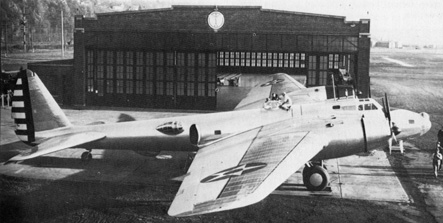
As a bomber the XB-15 failed due to a lack of suitably powerful engines. The prototype was developed into a transport and was flown during the war as the XC-105.
Type: long range bomber/transport
Crew: ?
Armament: none
Specifications:
Length: 87' 11" (26.80 m)
Height: 18' 0" (5.49 m)
Wingspan: 149' 0" (45.42 m)
Wing area: N/A
Empty Weight: N/A
Max Weight: 92,000 lb (41,731 kg) max at takeoff
Propulsion:
No. of Engines: 4
Powerplant: Pratt & Whitney Twin Wasp Senior radial
Horsepower: 1000 hp each
Performance:
Range: 5130 miles (8256 km)
Cruise Speed: N/A
Max Speed: 195 mph ( 314 km/h)
Ceiling: 18,900 ft (5760 m)
Douglas XB-19A
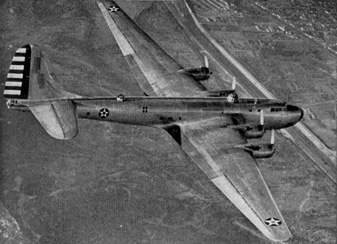
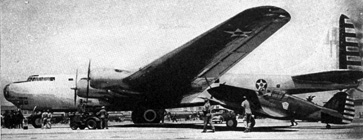
In 1934 the USAAC issued a specification for a long-range bomber that could be used to defend America's coastlines, as well as far-off outposts in Alaska, Hawaii, and Panama. Boeing responded with a prototype called the XBLR-1, and Douglas responded with the XBLR-2 (later designated the XB-19). When completed the XB-19 was then the largest aircraft built, with accommodation for a crew of ten and a bombload of 36,000 pounds. It flew for the first time on June 27, 1941. Unfortunately the four Wright R-3350-5 Cyclone engines that were in the prototype made the aircraft underpowered for the duty required of it, and it had to wait for the availability of more powerful engines. When these eventually materialized, the requirement had changed, and the Douglas giant was provided instead with four Allison engines. It was then operated in a transport role during WWII under the designation XB-19A.
Type: Long-range heavy bomber prototype
Crew: 10
Armament: two 37mm cannon
five 0.50-in. machine guns
six 0.30-in. machine guns
up to 36,000 lb of bombs
Specifications:
Length: 132' 0" (40.23 m)
Height: 42' 9" (13.03 m)
Wingspan: 212' 0" (64.62 m)
Wing area: 4492 sq. ft (417.31 sq. m)
Empty Weight: 82,253 lb (37,309 kg)
Max Weight: 164,000 lb (74,389 kg) max at takeoff
Propulsion:
No. of Engines: 4
Powerplant: Allison V-3420-11 inline engines
Horsepower: 2600 hp each
Performance:
Range: 7750 miles (12,472 km)
Cruise Speed: 186 mph ( 299 km/h)
Max Speed: 209 mph ( 336 km/h)
Ceiling: 22,000 ft (6705 m)
North American XB-28 Dragon
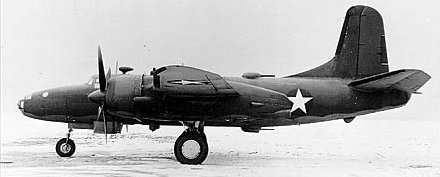
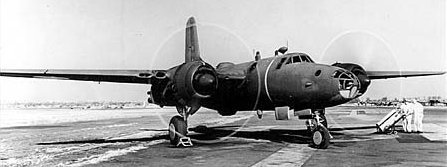
The XB-28 (North American model NA-63) was originally conceived as a high altitude version of the B-25 medium bomber. The resulting design, while maintaining the same overall configuration of the Mitchell (with the exception of a single vertical tail instead of B-25's twin tail), was visually more reminiscent of the B-26 Marauder. Other differences in the XB-28 design included a pressurized fuselage and three remote-controlled twin .50 caliber gun turrets (upper, lower, and tail). Two prototypes were ordered in February 1940, with the first flight taking place on April 26, 1942. After testing of the two prototypes, the project was canceled with no further examples being built. The reason for this, according to the USAF archives, was that "although the XB-28 was a successful design, the aircraft never went into production. One reason for this was high altitude bombing was too susceptible to errors caused by wind, cloud cover, etc. especially in the Pacific Theater of Operations. Another was the increasing effectiveness of medium bombers at low and medium levels along with improved tactics. Finally, the performance gains were not considered great enough to interrupt production of proven combat models." The second prototype XB-28 was built as a high altitude photo reconnaissance aircraft, and was designated XB-28A, but like the first XB-28 prototype it was the only one of its kind.
Type: high-altitude medium bomber
Crew: 5
Armament: six .50 cal machine guns
up to 4,000 lbs. of bombs
Specifications:
Length: 56' 5"
Height: 14' 0"
Wingspan: 72' 7"
Gross Weight: 35740 lb
Propulsion:
No. of Engines: 2
Powerplant: Pratt & Whitney R-2800 "Double Wasp" radial
Horsepower: 2000 each
Performance:
Range: 2040 miles
Cruise Speed: 255 mph
Max Speed: 372 mph
Ceiling: 33500 ft
Northrop XB-35 "Flying Wing"
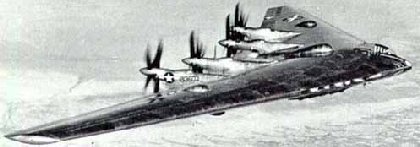
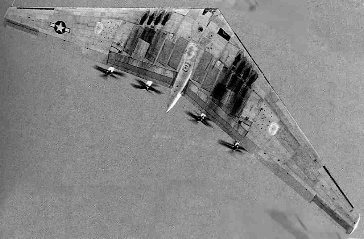
In 1941 Northrop was given a contract to develop a single long-range heavy bomber prototype, utilizing Northrop's flying wing design. It was given the designation XB-35, and while testing continued the contract was expanded to include a second prototype, then 13 test aircraft (designated YB-35), and finally an order for 200 production B-35s. Numerous engineering problems were encountered (including serious engine and propeller gear box difficulties), which delayed development to the point where the bomber would not be ready for WWII. Knowing this (and that upcoming jet bomber designs would soon make the XB-35 obsolete), the USAF canceled the production orders, and reduced the XB-35 program to testing only. Three of the YB-35s were then to be developed with jet engines, and these were re-designated YB-49s. The first flight of the XB-35 was finally made in June of 1946. With the YB-49s a more serious contender, the XB-35/YB-35 program was finally ended, with all prototypes being scrapped in 1949. The YB-49 program continued on into the 1950's, but it too was eventually canceled. Knowledge from these programs did not entirely go to waste, however, as some of it was used in the development of the B-2 Stealth bomber decades later.
Type: heavy bomber
Crew: 9
Armament: (first YB-35 only)
3 sets of 4 .50 cal machine guns in turrets
two .50 cal machine guns each in 4 barbettes
Specifications:
Length: 20' 1"
Height: 53' 1"
Wingspan: 172' 0"
Wing area: 4000 sq. ft
Empty Weight: 89,560 lb
Gross Weight: 180,000 lb
Max Weight: 209,000 lb
Propulsion:
No. of Engines: 4
Powerplant: two Pratt & Whitney R-4360-17 radials
two R-4360-21 Wasp Major radials
Horsepower: 3000 hp each
Performance:
Range: 8150 miles at 183 mph with a 16,000 pound bombload
720 miles at 240 mph with 51,070 pounds of bombs
Cruise Speed: 183 mph
Max Speed: 391 mph at 35,000 feet
Ceiling: 39,700 ft
Consolidated (Convair) XB-36 Peacemaker
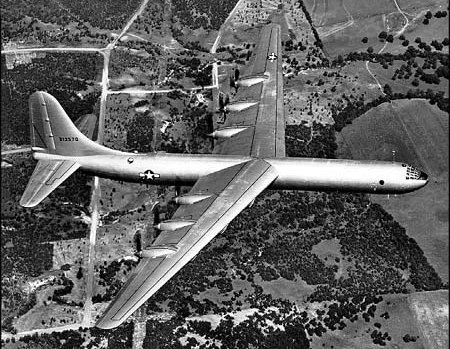
In 1941 a requirement for a bomber capable of bombing European targets from the Western Hemisphere was requested by the Army Air Corps. The Peacemaker was designed by Consolidated to meet those specifications, which included the ability to carry up to 72,000 pounds of bombs. The company designation for this aircraft was the Model 35, and it was designed to have twin fins and rudders (a feature that was later changed to be a single giant tail). Northrop aircraft was also designing an aircraft to meet the 1941 Air Force specification, and developed an aircraft that came to be known as theXB-35 Flying Wing. To avoid confusion with the Northrop bomber, the Model 35 was redesignated the Model 36, and a six engine design was settled upon. In November 1941 a contract for two prototypes was given by the Air Force. Consolidated was already busy building the B-24 Liberator(and later theB-32 Dominator), so progress on the XB-36 was slow. Consolidated Aircraft merged with Vultee Aircraft Inc. in March 1943, which lead to the unofficial name "Convair" (which became official in April 1954). In June 1943 General Hap Arnold placed an order for 100 examples of the B-36, with the first prototype to be ready for flight by September 1944. By mid-1944 the war was going better for the Allies, and the priority level of the XB-36 was reduced in light of the success of the Boeing B-29 Superfortress. Progress continued slowly, with the first XB-36 being rolled out on September 8, 1945, and achieving its first flight on August 8, 1946. The first B-36A took flight in August 1947, and the B-36 remained in service with the Strategic Air Command throughout the 1950s. However, by late 1958 the B-36 was phased out and replaced by the Boeing B-52 as the premier USAF heavy bomber.
Type: long range strategic bomber
Crew: 15
Armament: Designed for ten .50-cal. machine guns, five 37mm cannon
(No defensive armament was actually installed)
up to 77,784 lbs of bombs
Specifications:
Length: 163' 0"
Height: 46' 10"
Wingspan: 230' 0"
Wing area: 4772 square feet
Weight: 265,000 lbs. lb (max. gross weight)
Propulsion:
No. of Engines: 6
Powerplant: Pratt & Whitney R-4360-25 Wasp Major radial engines
Horsepower: 3000 hp each
Performance:
Range: 9500 miles with 10,000 pounds of bombs,
3850 miles with 77,784 pounds of bombs
Max Range: 3800 miles (6115 km)
Cruise Speed: 216 mph
Max Speed: 346 mph at 35000 ft
Max Ceiling: 38,000 ft
Douglas XB-42 Mixmaster
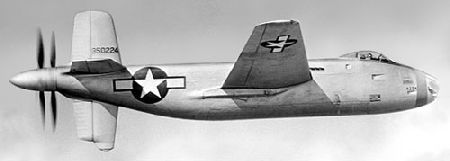
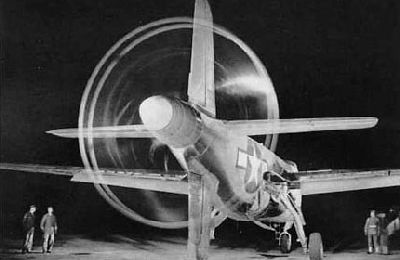
In 1943 the Douglas XB-42 project was designed to create a twin-engined bomber having a maximum speed in excess of 400 mph and capable of carrying a bombload of 2000 pounds to targets within a 2000-mile radius. This aircraft was envisaged to be an attack aircraft, but the USAAF changed its designation from XA-42 to XB-42 with the view that this bomber would be a potential substitute for the Boeing B-29 (if the Boeing project became hung up in development). The XB-42 bomber was unique in that both of its engines were located inside of the fuselage (turning a pair of contra-rotating propellers in the tail), which allowed the wing to have a clean unfettered design. The aircraft had a crew of three, and was armed with a turret contained two .50 caliber machine guns in the trailing edge of each wing. The first prototype flew in May 1944, and proved to have outstanding performance. Its top speed was over 400 mph, which was comparable to the fast British Mosquito, but the XB-42 carried twice the maximum bombload, and was better armed. Development continued until December 1945, at which time it was decided not to produce the B-42, due to the fact that jet-powered bombers were already on the drawing boards. The second prototype was modified to have turbojets under the wings for testing purposes, and was re-designated XB-42A. The project was finally canceled in 1948, with the sole-remaining example being turned over to the National Air and Space Museum in 1949. The final legacy of this project was a redesigned version with the jet engines placed inside of the fuselage, designated the XB-43.
Type: bomber
Crew: 3
Armament: Two pair remotely-controlled 0.50-inch
machine guns on each wing
Four 2000-pound bombs.
Specifications:
Length: 53' 8"
Height: 18' 10"
Wingspan: 70' 6"
Wing area: 555 sq. ft
Empty Weight: 20,888 lb
Gross Weight: 33,208 lb
Max Weight: 35,702
Propulsion:
No. of Engines: 2
Powerplant: Allison V-1710-125 liquid-cooled V-12
Horsepower: 1800 hp each
Performance:
Range: 1800 miles (maximum: 5400 miles)
Cruise Speed: 312 mph
Max Speed: 410 mph at 23,440 ft, 344 mph at sea level.
Ceiling: 29,400 ft
Douglas XB-43 Jetmaster
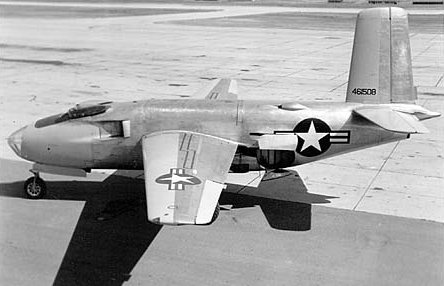
The Douglas XB-43 project was initiated in late 1943, and was basically an all-jet powered revision of the XB-42 design. Two prototypes were built, with the first flight taking place in May of 1946. After several years of being used for testing purposes, the aircraft were retired in 1953. See the links below for more information on this aircraft.
Type: jet bomber
Crew: three
Armament: two .50 cal machine guns in tail (never installed)
up to 8000 lbs. of bombs
Specifications:
Length: 51' 5"
Height: 24' 3"
Wingspan: 71' 1"
Wing area: 325 sq. ft (30 sq. m)
Weight: 40,000 lbs. (max. gross weight)
Propulsion:
No. of Engines: 2
Powerplant: General Electric J35-GE-3 (TG-180) axial flow turbojets
Horsepower: 4,000 lbs. thrust each
Performance:
Range: 2500 miles
Cruise Speed: 410 mph
Max Speed: 503 mph
Climb: 2470 ft/min initial climb rate
Ceiling: 38500 ft
North American XB-45 Tornado
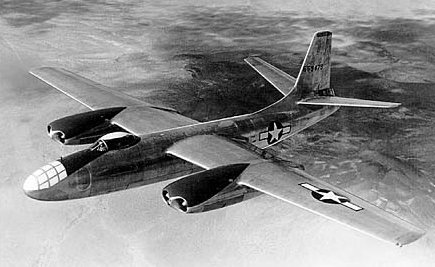
Type: jet bomber
Crew: 1, Pilot
Armament: two .50 cal machine guns in tail
up to 8000 lbs of bombs, or one 22,000 bomb
Specifications:
Length: 74' 0"
Height: 25' 2"
Wing span: 89' 6"
Wing area: 235 sq. ft (21.80 sq. m)
Weight: 66,820 lbs. (gross weight)
Propulsion:
No. of Engines: 4
Powerplant: Allison J35-A-11 turbojets
Horsepower: 4,000 lbs. thrust each
Performance:
Range: 2920 miles
Cruise Speed: 419 mph
Max Speed: 500 mph
Ceiling: 38,500 ft
Consolidated XB-46
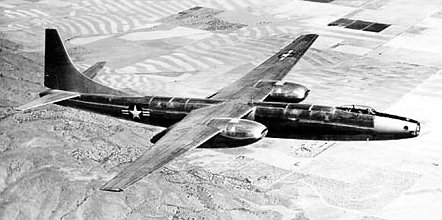
Type: jet bomber
Crew: three
Armament: two .50 cal machine guns in tail
up to 22,000 lbs. of bombs
Specifications:
Length: 105' 9"
Height: 27' 11"
Wing span: 113' 0"
Wing area: 235 sq. ft (21.80 sq. m)
Weight: 95,600 lbs. (maximum takeoff weight)
Propulsion:
No. of Engines: 4
Powerplant: Allison J35-A-3 axial flow turbojets
Horsepower: 4,000 lbs. thrust each
Performance:
Range: 2,870 miles with 8,000 lbs. of bombs
Cruise Speed: 439 mph
Max Speed: 545 mph at 15,000 feet
Ceiling: 43,000 ft
Boeing XB-47 Stratojet
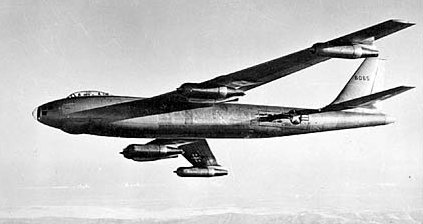
Type: jet bomber
Crew: three
Armament: two .50 cal machine guns in tail
up to 22,000 lbs. of bombs
Specifications:
Length: 107' 6"
Height: 27' 8"
Wingspan: 116' 0"
Gross Weight: 162,500 lbs. (maximum takeoff weight)
Propulsion:
No. of Engines: 6
Powerplant: General Electric J35-GE-7 axial flow turbojets
Horsepower: 4,000 lbs. thrust each
Performance:
Range: 2650 miles w/ 10000 lb. bombload
Cruise Speed: 476 mph
Max Speed: 578 mph at 15,000 feet
Ceiling: 37,500 ft
Martin XB-48
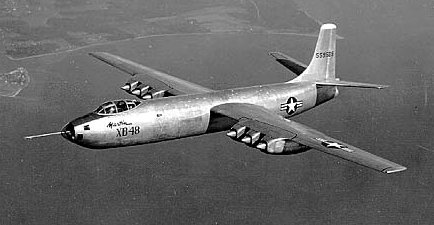
Type: jet bomber
Crew: three
Armament: two .50 cal machine guns in tail
up to 22,000 lbs. of bombs
Specifications:
Length: 85' 9"
Height: 26' 6"
Wingspan: 108' 4"
Gross Weight: 58500 lb empty, 92600 max
Propulsion:
No. of Engines: 6
Powerplant: General Electric J35-GE-7 axial-flow turbojets
Horsepower: 3820 lb.s.t. each
Performance:
Range: 500 miles with max bombload
Cruise Speed: 415 mph
Max Speed: 516 mph at 20,000 feet
Ceiling: 39400 ft